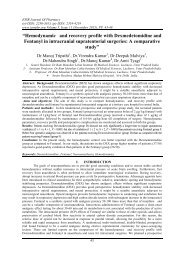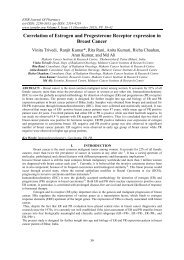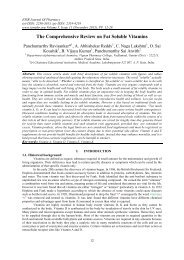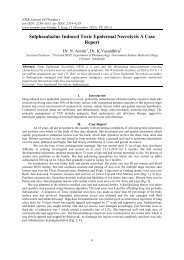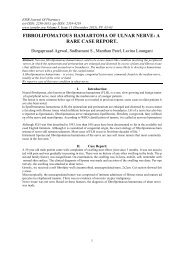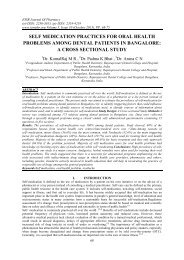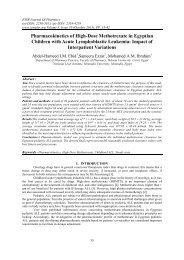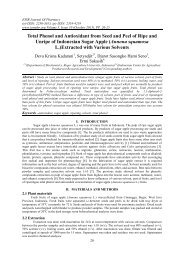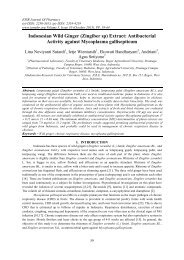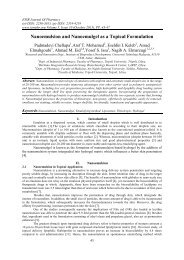Complete NMR Assignment of MogrosidesII A2, II E andIII A1Isolated from Luo Han Guo
NMR analysis allowed complete assignments of three known mogrol glycosides, Mogroside IIA2 (1), II E (2)and IIIA1 (3), isolated from the extracts of Luo Han Guo. Herein, complete 1H and 13C NMR assignmentsof all threemogrosidesare described based on NMR experiments (1H NMR, 13C NMR, COSY, HSQC-DEPT, HMBC, NOESY and 1DTOCSY) and mass spectral data.
NMR analysis allowed complete assignments of three known mogrol glycosides, Mogroside IIA2 (1), II E (2)and IIIA1 (3), isolated from the extracts of Luo Han Guo. Herein, complete 1H and 13C NMR assignmentsof all threemogrosidesare described based on NMR experiments (1H NMR, 13C NMR, COSY, HSQC-DEPT, HMBC, NOESY and 1DTOCSY) and mass spectral data.
Create successful ePaper yourself
Turn your PDF publications into a flip-book with our unique Google optimized e-Paper software.
IOSR Journal Of Pharmacy<br />
(e)-ISSN: 2250-3013, (p)-ISSN: 2319-4219<br />
www.iosrphr.org Volume 5, Issue 10 (October 2015), PP. 48-53<br />
<strong>Complete</strong> <strong>NMR</strong> <strong>Assignment</strong> <strong>of</strong> <strong>Mogrosides<strong>II</strong></strong> A 2 , <strong>II</strong> E and<strong>II</strong>I<br />
A 1 Isolated <strong>from</strong> <strong>Luo</strong> <strong>Han</strong> <strong>Guo</strong><br />
Indra Prakash a* , SangphyoHong a , Cynthia Bunders a , Gil Ma a , Krishna P.<br />
Devkota b , Romila D.Charan b , Jim Callahan b , Tara M. Snyder b , and<br />
Catherine Ramirez b<br />
a The Coca-Cola Company, One Coca-Cola Plaza, Atlanta, GA 30313, USA<br />
b AMRI-Albany, Analytical Development,Albany, NY 12212, USA<br />
Abstract : <strong>NMR</strong> analysis allowed complete assignments <strong>of</strong> three known mogrol glycosides, Mogroside <strong>II</strong>A 2 (1),<br />
<strong>II</strong> E (2)and <strong>II</strong>IA 1 (3), isolated <strong>from</strong> the extracts <strong>of</strong> <strong>Luo</strong> <strong>Han</strong> <strong>Guo</strong>. Herein, complete 1 H and 13 C <strong>NMR</strong><br />
assignments<strong>of</strong> all threemogrosidesare described based on <strong>NMR</strong> experiments ( 1 H <strong>NMR</strong>, 13 C <strong>NMR</strong>, COSY,<br />
HSQC-DEPT, HMBC, NOESY and 1DTOCSY) and mass spectral data.<br />
Keywords:Mogroside, Structure elucidation, <strong>NMR</strong>, <strong>Luo</strong> <strong>Han</strong> <strong>Guo</strong>.<br />
I. Introduction<br />
Due to high demand <strong>of</strong> non-caloric sweeteners <strong>from</strong> natural sources, the food industry has been<br />
showing great interest in the discovery <strong>of</strong> high potency sweeteners <strong>from</strong> plants or fruits. Since the 1970s,<br />
steviolglycocidesextracted <strong>from</strong> the leaves <strong>of</strong> Stevia rebaudiana, such as Rebaudioside A, have been studied<br />
extensively and commercialized as zero-calorie high potency sweeteners [1, 2]. By the same token, extracts<br />
<strong>from</strong> the fruit <strong>of</strong> Siraitiagrosvenorimainly grown in southern China, knownas <strong>Luo</strong> <strong>Han</strong> <strong>Guo</strong>, have drawn a great<br />
deal <strong>of</strong> attention <strong>from</strong> the food industry for the development <strong>of</strong> sweet taste additives [3-7]. More recently, it has<br />
been developed into a non-caloric sweetener to compete with other herbal sweeteners such as stevioside [8, 9].<br />
Mogrosideshavebeenused as a traditional medicine for treating conditions such as lung congestion and sore<br />
throats [10]. Recently, threeresearch groups reported that mogrosides exhibit antioxidant, antidiabetic and<br />
anticancer activities [11-13].The sweet components <strong>of</strong> <strong>Luo</strong> <strong>Han</strong> <strong>Guo</strong>aretriterpene glycosides, known as<br />
mogrosides. Mogrosides possess a polycyclic cucurbitane core in common and several derivatives are isolated<br />
including Mogroside <strong>II</strong>I, IV, V, <strong>II</strong> A 2 , <strong>II</strong> E and <strong>II</strong>I A 1 . The mixed mogrosides have been estimated to be about<br />
300 times as sweet as sucrose. Among them, Mogroside V is most responsible for sweetness beingabout 400<br />
times sweeter than sucrose. <strong>Luo</strong> <strong>Han</strong> <strong>Guo</strong> fruit extracts containing 25 – 55% Mogroside V are a generally<br />
recognized as safe (GRAS) non-nutritive sweetener and flavor enhancerin the USA [14], and the purified<br />
Mogroside V has been approved as a high-potency sweetening agent in Japan [15].In continuation <strong>of</strong> our study<br />
on the isolation <strong>of</strong> natural sweeteners <strong>from</strong> Lu <strong>Han</strong> <strong>Guo</strong> extracts following Mogroside <strong>II</strong>I A 2 and 11-<br />
deoxymogroside <strong>II</strong>I [16], we describe in this report the isolation and full structure elucidation <strong>of</strong> the three<br />
additional mogrosides, <strong>II</strong> A 2 (1), <strong>II</strong> E (2) and <strong>II</strong>I A 1 (3) (Figure 1). Compounds 1, 2 and 3 have been previously<br />
reported but their complete <strong>NMR</strong> assignments have not been published.For Mogroside <strong>II</strong> A 2 (1) the assignments<br />
<strong>of</strong> only the anomeric protons is reported [5] whereas the 13 C <strong>NMR</strong> assignments <strong>of</strong> Mogroside <strong>II</strong> E (2) are<br />
published but the complete 1 H <strong>NMR</strong> assignments are not published [17].For Mogroside <strong>II</strong>I A 1 ,(3) the complete<br />
1 H and 13 C <strong>NMR</strong> assignments have been reported [18].Although partial and complete <strong>NMR</strong> assignments have<br />
been reported for Mogroside <strong>II</strong> E and Mogroside <strong>II</strong>I A 1 , respectively, some <strong>of</strong> the reported assignments arein<br />
errorforMogroside <strong>II</strong> E. In this paper we describe the isolation and complete <strong>NMR</strong> assignments <strong>of</strong> compounds1,<br />
2 and 3.<br />
48
<strong>Complete</strong> <strong>NMR</strong> <strong>Assignment</strong> <strong>of</strong> <strong>Mogrosides<strong>II</strong></strong>…<br />
<strong>II</strong>. Materials and Methods<br />
The material used for the isolation <strong>of</strong> Mogroside <strong>II</strong>A 2 , <strong>II</strong> E and <strong>II</strong>IA 1 was <strong>Luo</strong> <strong>Han</strong> <strong>Guo</strong> extract (10 g) purchased<br />
<strong>from</strong> Chengdu Biopurify Phytochemicals, China.<br />
General Methods<br />
<strong>NMR</strong> sampleswerepreparedin CD 3 OD (~1.4-2 mg/130-150 µL) and <strong>NMR</strong> data were acquired on BrukerAvance<br />
500 MHz instruments with either a 2.5 mm inverse probe or a 5 mm broad band probe. The 1 H and 13 C <strong>NMR</strong><br />
spectra were referenced to the solvent resonance at H 3.30 ppm and C 49.0 ppm, respectively. MS and MS/MS<br />
data were generated with a Waters QT<strong>of</strong> Micro mass spectrometer equipped with an electrospray ionization<br />
source. The sampleswereanalyzed by negative ESI. The samples (~0.1 mg) werediluted with 50:50<br />
MeCN:H 2 Oeither with or without 0.1% NH 4 OH and introduced via direct infusion.<br />
Isolation and Purification<br />
Primary preparative processing <strong>of</strong> <strong>Luo</strong> <strong>Han</strong> <strong>Guo</strong>extract was performed by purifying on a pre-packed Waters X-<br />
Bridge C-18 column using a Waters Delta Prep LC Model 2000/4000 system(Injection: 1~2 g in 15 mL <strong>of</strong><br />
DMSO and 25 mL <strong>of</strong> water Mobile phase <strong>of</strong> solvent system:0.05% HOAc in water (A), 0.05% HOAc in MeCN<br />
(B) and 0.5% HOAc in MeOH (C);gradient: 90:10:0 (A:B:C, 0-15 min), 50:50:0 (55 min), 0:100:0 (60-70 min)<br />
and then 25:0:75(71-75 min); flow rate:105 mL/min, Detection: UV at 225 nm). Corresponding combined<br />
fractions contained mogrosides were subjected to consecutive secondarypreparative purification processing to<br />
afford Mogrosides <strong>II</strong> A 2 , <strong>II</strong>E and <strong>II</strong>I A 1 .<br />
<strong>II</strong>I. Results and Discussion<br />
Compounds 1, 2 and 3 were isolated as white solids. The ESI-TOF mass spectrum forMogroside <strong>II</strong> A 2 (1)<br />
showed a [M-H] - ion at m/z 799.4817 which upon accurate mass measurement provided the molecular formula<br />
C 42 H 72 O 14 (calcd for C 42 H 71 O 14 : 799.4844, error: -3.4 ppm). Similarly, the ESI-TOF mass spectrum acquired for<br />
Mogroside <strong>II</strong> E (2) showed a [M-H] - ion at 799.4738 which also corresponded to the molecular formula<br />
C 42 H 72 O 14 (calcd for C 42 H 71 O 14 : 799.4844, error: -1.6 ppm) indicative <strong>of</strong> compounds1 and 2being isomers. For<br />
Mogroside <strong>II</strong>I A 1 (3), ESI-TOF mass spectrum showed a [M-H] - ion at m/z 961.5316 and accurate mass<br />
measurement provided the molecular formula C 48 H 82 O 19 (calcd for C 48 H 81 O 19 : 961.5372, error: -5.8 ppm).<br />
The 1D and 2D <strong>NMR</strong> data showed that theMogrosides <strong>II</strong> A 2 (1), <strong>II</strong> E (2) and <strong>II</strong>I A 1 (3) share the same<br />
triterpenecentral core with seven methyl singletsbetween 0.86 – 1.18, a methyl doublet between 0.96 – 0.97,<br />
eight methylenes between 1.13 – 2.42, fourmethine protons between 1.45 – 2.50, three additional methines<br />
between 3.21-3.85, the chemical shifts indicative <strong>of</strong> these methines being attached to carbons bearing oxygen<br />
groups, and a tertiary hydroxyl carbon between c 73.6 – 73.9. The three compounds vary by the substituents <strong>of</strong><br />
secondary alcohols at C-3 and C-24 in the Mogroside core. The triterpenoidaglycone central core for compound<br />
1 was supported by 1 H- 1 H COSY correlations <strong>of</strong> H-1/H-2; H-2/H-3; H-6/H-7; H-7/H-8; H-10/H-1; H-11/H-12;<br />
H-15/H-16; H-16/H-17; H-17/H-20; H-20/H-21; H-20/H-22; H-22/H-23 and H-23/H-24 and 1 H- 13 C HMBC<br />
correlations <strong>of</strong> H-6/C-4, C-8; H-8/C-6, C-14; H-11/C-9, C-10, C-19; H-18/C-12, C-13, C-14, C-17; H-19/C-8,<br />
C-9, C-10; H-21/C-17, C-20, C-22; H-24/C-23, C-25; H-26 and H-27/C-24, C-25; H-28 and H-29/C-3, C-4, C-5<br />
and H-30/C-8, C-13, C-14, C-15.The key 1 H- 1 H COSY and 1 H- 13 C HMBC correlations used to assign the<br />
aglycone unit <strong>of</strong> 1 are provided in Figure 2 (A).The COSY and HMBC correlations observed for compounds 2<br />
and 3 were consistent with compound 1. The complete 1 H and 13 C <strong>NMR</strong> assignments<strong>of</strong> the aglycones <strong>of</strong> all three<br />
compounds were madeon the basis <strong>of</strong> 1 H, 13 C,COSY, HSQC-DEPTand HMBC dataand aregiven in Table 1.<br />
The relative stereochemistry <strong>of</strong> the central triterpene core was assigned based on NOE correlations. In the<br />
NOESY spectrum <strong>of</strong> 1, NOE correlations <strong>of</strong> H-10/H-28, H-10/H-30 and H-30/H-17 indicated that H-10, H-17,<br />
H-28, and H-30 are on the same face <strong>of</strong> the rings. Similarly, NOE correlations <strong>of</strong>H-8/H-18, H-8/H-19, H-11/ H-<br />
18, H-11/H-19 indicated that H-8, H-11, H-18 and H-19 are on the same face <strong>of</strong> the ring.Absence <strong>of</strong> NOE<br />
correlations between H-8/H-11/H-18/H-19 and H-10/H-17/H-28/H-30 indicated that these were on the opposite<br />
face <strong>of</strong> the rings as presented in Figure 2. Also, NOE correlations observed between H-17 and H-21 indicated<br />
that they are on the same face. Based on the available NOESY data, the relative stereochemistry <strong>of</strong> H-3 and H-<br />
29 could not be assigned unambiguously. However, based on large coupling constant (7.8 Hz, β-configuration)<br />
<strong>of</strong> Glc IV anomeric proton and its attachment at C-3 <strong>of</strong> the central triterpene core (discussed below), the H-3<br />
would most likely be in α-orientation. Also, since the relative stereochemistry <strong>of</strong>H-28 is assigned as α, the<br />
relative stereochemistry <strong>of</strong>H-29 would be β as shown in figure 2.The relative stereochemistry for the central<br />
triterpene core <strong>of</strong> compounds2 and 3 were similarly assigned are consistent with Mogroside <strong>II</strong> A 2 (1) (Figure 2).<br />
49
<strong>Complete</strong> <strong>NMR</strong> <strong>Assignment</strong> <strong>of</strong> <strong>Mogrosides<strong>II</strong></strong>…<br />
Table 1. 1 H and 13 C <strong>NMR</strong> (500 and 125 MHz, CD 3 OD), assignments foraglycone <strong>of</strong> 1, 2, and 3.<br />
1 2 3<br />
Position<br />
13 C<br />
1 H<br />
13 C<br />
1 H<br />
13 C<br />
1 H<br />
1<br />
27.2 1.48 m<br />
27.2 1.51 m<br />
26.4 1.51 m<br />
2.22 m<br />
2.21 m<br />
2.22 m<br />
2<br />
29.7 1.90 m<br />
29.6 1.92 m<br />
30.5 1.54 m<br />
1.92 m<br />
1.94 m<br />
2.00 m<br />
3 88.2 3.46 m 88.5 3.41 m 77.6 3.41 m<br />
4 42.9 --- 42.9 --- 42.6 ---<br />
5 144.9 --- 144.9 --- 144.1 ---<br />
6 119.6 5.48 brd (5.9) 119.7 5.49 d (5.3) 120.5 5.47 d (6.1)<br />
7<br />
25.1 1.80 m<br />
2.38 dd<br />
(18.7, 7.2)<br />
25.1 1.80 m<br />
2.38 m<br />
25.1 1.80 m<br />
2.42 dd<br />
(18.0, 6.8)<br />
8 44.7 1.66 d (7.4) 44.7 1.66 brd (7.4) 44.7 1.67 d (7.5)<br />
9 40.9 --- 40.9 --- 40.9 ---<br />
10 37.3 2.48 brd (12.0) 37.5 2.47 brd (11.7) 37.1 2.50 brd (12.4)<br />
11 79.4 3.85 m 79.4 3.84 m 79.4 3.85 m<br />
12<br />
41.1 1.80 m<br />
41.1 1.80 m<br />
41.1 1.81 m<br />
1.83 m<br />
1.83 m<br />
1.86 m<br />
13 48.2 --- 48.2 --- 48.3 ---<br />
14 50.6 --- 50.6 --- 50.6 ---<br />
15<br />
35.3 1.13 m<br />
35.4 1.13 m<br />
35.4 1.14 m<br />
1.19 m<br />
1.19 m<br />
1.21 m<br />
16<br />
29.1 1.34 m<br />
29.1 1.34 m<br />
29.4 1.33 m<br />
1.96 m<br />
1.98 m<br />
1.98 m<br />
17 51.8 1.60 m 51.7 1.62 m 51.8 1.62 m<br />
18 17.1 0.91 s 17.1 0.91 s 17.1 0.91 s<br />
19 26.2 1.10 s 26.2 1.10 m 26.2 1.14 s<br />
20 37.0 1.50 m 37.3 1.47 m 37.5 1.45 m<br />
21 19.1 0.96 d (6.3) 19.1 0.96 d (4.9) 19.3 0.97 d (6.3)<br />
22<br />
34.4 1.27 m<br />
34.2 1.48 m<br />
34.1 1.48 m<br />
1.48 m<br />
1.52 m<br />
1.55 m<br />
23<br />
28.8 1.34 m<br />
29.7 1.47 m<br />
29.9 1.40 m<br />
1.50 m<br />
1.59 m<br />
1.54 m<br />
24 79.7 3.21 m 89.7 3.44 m 93.3 3.39 m<br />
25 73.9 --- 73.6 --- 73.9 ---<br />
26 25.0 † 1.12 s † 26.6 † 1.14 s † 26.8 † 1.10 s †<br />
27 25.6 † 1.14 s † 24.7 † 1.15 s † 24.1 † 1.14 s †<br />
28 27.8 1.06 s 27.8 1.06 s 27.5 1.05 s<br />
29 26.2 1.18 s 26.3 1.18 s 26.4 1.09 s<br />
30 19.8 0.87 s 19.8 0.86 s 20.0 0.88 s<br />
† <strong>Assignment</strong>s can be interchanged.<br />
50
<strong>Complete</strong> <strong>NMR</strong> <strong>Assignment</strong> <strong>of</strong> <strong>Mogrosides<strong>II</strong></strong>…<br />
Table 2. 1 H and 13 C <strong>NMR</strong> (500 and 125 MHz, CD 3 OD), assignments forthe glycosides <strong>of</strong> 1, 2, and 3.<br />
1 2 3<br />
Position<br />
13 C<br />
1 H<br />
13 C<br />
1 H<br />
13 C<br />
1 H<br />
Glc I -1 --- --- 104.9 4.33 d (7.7) 104.2 4.43 d (7.3)<br />
Glc I -2 --- --- 75.3 3.21 m 81.2 3.61 m<br />
Glc I -3 --- --- 78.0 or 78.1 3.35 m 78.7 3.59 m<br />
or 78.3<br />
Glc I -4 --- --- 71.6 or 71.7 3.28 m 71.6 3.33 m<br />
Glc I -5 --- --- 78.0 or 78.1 3.27 m 76.5 3.50 m<br />
or 78.3<br />
Glc I -6 --- --- 62.6 3.64 m<br />
3.84 m<br />
70.1 3.62 m<br />
4.23 dd<br />
(10.4, 1.8)<br />
Glc <strong>II</strong> -1 --- --- --- --- 104.4 or 104.5 4.28 d (7.7)<br />
Glc <strong>II</strong> -2 --- --- --- --- 75.2 3.20 m<br />
Glc <strong>II</strong> -3 --- --- --- --- 77.7-78.2 ¥ 3.36 m<br />
Glc <strong>II</strong> -4 --- --- --- --- 71.6 3.27 m<br />
Glc <strong>II</strong> -5 --- --- --- --- 77.7-78.2 ¥ 3.26 m<br />
Glc <strong>II</strong> -6 --- --- --- --- 62.7 3.65 m<br />
3.85 m<br />
Glc <strong>II</strong>I -1 --- --- --- --- 104.4 or 104.5 4.77 d (7.8)<br />
Glc <strong>II</strong>I -2 --- --- --- --- 75.7 3.27 m<br />
Glc <strong>II</strong>I -3 --- --- --- --- 77.7-78.2 ¥ 3.36 m<br />
Glc <strong>II</strong>I -4 --- --- --- --- 72.4 3.21 m<br />
Glc <strong>II</strong>I -5 --- --- --- --- 77.7-78.2 ¥ 3.27 m<br />
Glc <strong>II</strong>I -6 --- --- --- --- 63.6 3.63 m<br />
3.86 m<br />
Glc IV -1 106.4 4.28 d (7.8) 106.6 4.27 d (7.8) --- ---<br />
Glc IV -2 75.2 or 75.6 3.19 m 75.6 3.18 m --- ---<br />
Glc IV -3 78.1 3.31 m 78.0 or 78.1 3.31 m --- ---<br />
or 78.3<br />
Glc IV -4 71.6 3.29 m 71.6 or 71.7 3.26 m --- ---<br />
Glc IV -5 77.2 3.40 m 77.7 3.21 m --- ---<br />
Glc IV -6 69.8 3.80 m<br />
4.05 dd<br />
62.8 3.65 m<br />
3.81 m<br />
--- ---<br />
(11.8, 1.5)<br />
Glc V -1 104.8 4.42 d (7.8) --- --- --- ---<br />
Glc V -2 75.2 or 75.6 3.18 m --- --- --- ---<br />
Glc V -3 77.9 or 78.0 3.35 m --- --- --- ---<br />
Glc V -4 71.6 3.28 m --- --- --- ---<br />
Glc V -5 77.9 or 78.0 3.25 m --- --- --- ---<br />
Glc V -6 62.7 3.66 m --- --- --- ---<br />
3.85 m<br />
¥ Four carbon resonances in the range <strong>of</strong> 77.7-78.2 (77.66, 77.92, 77.05, and 78.16), hence chemical shifts could not be unequivocally assigned.<br />
The 1 H and 1 H- 13 C HSQC-DEPT data allowed identification <strong>of</strong> the two anomeric protons inMogroside <strong>II</strong> A 2<br />
which were well resolved at H 4.42 ( C 104.8) and 4.28 ( C 106.4) and both protons had large couplings (7.8<br />
Hz) indicating that they had β-configurations. The anomeric proton at H 4.28 showed an HMBC correlation to<br />
C-3 ( C 88.2)which indicated that it corresponded to Glc IV H-1.Glc IV H-2 and H-3 were then assigned based on<br />
COSY correlation between Glc IV H-1/Glc IV H-2 and Glc IV H-2/Glc IV H-3.Due to data overlap the COSY<br />
spectrum did not allow assignment <strong>of</strong> remaining Glc IV protons. Therefore, 1D TOCSY experiments were<br />
performed to assignGlc IV H-4, H-5 and H-6. HSQC-DEPT data was then used to assign the carbon chemical<br />
shift <strong>of</strong> Glc IV C-1 to C-6.HMBC correlations <strong>of</strong>Glc IV H-1/C-2, C-3, C-5; H-2/C-1; H-3/C-2, C-4;H-4/C-6 and H-<br />
6/C-4 further confirmed the assignments.The complete 1 H and 13 C assignments forGlc IV are presented in Table 2.<br />
The downfield carbon chemical shift <strong>of</strong> C-6 (δ C 69.8) indicated that the hydroxyl group at C-6 is replaced by a<br />
sugar linkage.The anomeric proton <strong>of</strong> Glc V at H 4.42 showed an HMBC correlation to the carbon at C 69.8<br />
ppm (Glc IV C-6) and the reciprocal HMBC correlations <strong>from</strong> the methylene protons <strong>of</strong> Glc IV ( H 3.80 and 4.05)<br />
to the anomeric carbon <strong>of</strong>Glc V at C 104.8 confirmedthe 16 linkage between Glc V and Glc IV .The remaining<br />
proton and carbon assignments for Glc V wasdone as discussed above for Glc IV . The key 1 H- 1 H COSY and 1 H- 13 C<br />
HMBCcorrelations for theglycone unit <strong>of</strong> Mogroside <strong>II</strong> A 2 (1) are presented in Figure 2 (B) and the complete<br />
proton and carbon assignments are presented in Table 2.<br />
51
<strong>Complete</strong> <strong>NMR</strong> <strong>Assignment</strong> <strong>of</strong> <strong>Mogrosides<strong>II</strong></strong>…<br />
Similarly in Mogroside <strong>II</strong> E(2),the presence <strong>of</strong> two anomeric protons were confirmed at H 4.33 ( C 104.9) and<br />
4.27 ( C 106.6), having coupling <strong>of</strong> 7.7 Hz and 7.8 Hz, respectively, indicating that they<br />
hadconfigurations.The anomeric proton at H 4.27 showed an HMBC correlation to C-3( C 88.5)hence<br />
establishing the linkage <strong>of</strong>Glc IV to C-3. The anomeric proton at H 4.33 showed an HMBC correlation to C-24<br />
( C 88.7)establishing the linkage <strong>of</strong>Glc I to C-24. The COSY and 1D-TOCSY data allowed the assignments <strong>of</strong><br />
Glc I and Glc IV H-2 to H-6 while the carbon assignments were based on HSQC-DEPT data and confirmed by<br />
HMBC correlations... The key 1 H- 1 H COSY and 1 H- 13 C HMBCcorrelations usedto assign the glucose units and<br />
their attachment to the triterpene core in Mogroside <strong>II</strong> E (2) are presented in Figure 3 and the complete proton<br />
and carbon assignments are presented in Table 2. Compound 2 is an isomer <strong>of</strong> compound 1, differing only in the<br />
position <strong>of</strong> the attachment <strong>of</strong> glucose units.<br />
In Mogroside <strong>II</strong>I A 1 (3), the 1 H and HSQC-DEPT <strong>NMR</strong> data confirmed the presence <strong>of</strong> three glucose<br />
units.Theanomeric protons <strong>of</strong> these glucose units were observed at H 4.77 ( C 104.4 or 104.5), 4.43 ( C 104.2),<br />
and 4.28 ( C 104.4 or 104.5) and had large couplings (7.3 – 7.8 Hz) indicating that they had β-configurations.<br />
The anomeric proton at H 4.43 showed an HMBC correlation to C-24 ( C 93.3)which indicated that it<br />
corresponded to the anomeric proton <strong>of</strong> Glc I . The COSY and 1D-TOCSY experiments allowed the assignment<br />
<strong>of</strong> Glc I H-2 to Glc I H-6 and the HSQC-DEPT data was used to assign Glc I C-2 to Glc I C-6. HMBC correlations<br />
<strong>of</strong>Glc I H-1/C-3; H-2/C-1, C-3; H-3/C-2; H-4/C-3, C-6 and H-5/C-6 further confirmed the assignments. The<br />
complete 1 H and 13 C assignments forGlc I are presented in Table 2. The downfield carbon chemical shifts <strong>of</strong> C-2<br />
(δ C 81.2) and C-6 (δ C 70.1) indicated that the hydroxyl groups at C-2 and C-6 arereplaced by sugar linkages<br />
which was subsequently confirmed byHMBC correlations. The anomeric proton <strong>of</strong> Glc <strong>II</strong> at H 4.28 showed an<br />
HMBC correlation to the carbon at C 70.1 ppm (Glc I C-6) and the reciprocal HMBC correlation <strong>from</strong> the<br />
methylene protons <strong>of</strong> Glc I ( H 3.62 and 4.23) to the anomeric carbon <strong>of</strong>Glc <strong>II</strong> at C 104.4 or 104.5 confirmed the<br />
16 linkage between Glc <strong>II</strong> and Glc I . Similarly, HMBC correlation <strong>from</strong> the anomeric proton <strong>of</strong> Glc <strong>II</strong>I at H 4.77<br />
to the carbon at C 81.2 ppm (Glc I C-2) and the reciprocal HMBC correlation <strong>from</strong> the methine proton <strong>of</strong> Glc I H-<br />
2 ( H 3.61) to the anomeric carbon <strong>of</strong>Glc <strong>II</strong>I at C 104.4 or 104.5 confirmed the 12 linkage between Glc <strong>II</strong>I and<br />
Glc I .The assignment <strong>of</strong> remaining protons and carbons <strong>of</strong> Glc <strong>II</strong> and Glc <strong>II</strong>I were done based on COSY, HSQC-<br />
DEPT, HMBC and 1D-TOCSY data. A summary <strong>of</strong> the key 1 H- 1 H COSY and 1 H- 13 C HMBCcorrelations <strong>of</strong><br />
Mogroside <strong>II</strong>I A 1 (3) used to assign the C-24 glycosides are described in Figure 4 and the complete 1 H and 13 C<br />
assignments are presented in Table 2.<br />
52
<strong>Complete</strong> <strong>NMR</strong> <strong>Assignment</strong> <strong>of</strong> <strong>Mogrosides<strong>II</strong></strong>…<br />
The 13 C <strong>NMR</strong> assignmentsfor compound 2 reported by Si et al. [15] for position 28 and 30 are incorrect, the<br />
assignments are swapped. Similarly, for compound 3,the 13 C <strong>NMR</strong> assignments reported by Li et al [16] for<br />
position 26 and 27 are swapped.<br />
IV. Conclusions<br />
This report describes complete <strong>NMR</strong> assignments for Mogrosides <strong>II</strong> A 2 , <strong>II</strong> E and <strong>II</strong>I A 1 through extensive <strong>NMR</strong><br />
analysis. The structures <strong>of</strong> Mogrosides <strong>II</strong> A 2 , <strong>II</strong> E and <strong>II</strong>I A 1 are disclosed in the literature, however, full <strong>NMR</strong><br />
assignmentshave not beenreported for Mogroside <strong>II</strong> A 2 and only partial assignment have been reported for<br />
Mogroside <strong>II</strong> E.<br />
References<br />
[1] Brandle, J.E.; Starrratt, A.N.; Gijen, M. Stevia rebaudiana: Its agricultural, biological andchemical properties. Can. J. Plant<br />
Sci.1998, 78, 527–536.<br />
[2] Chaturvedula, V.S.P.; Rhea, J.; Milanowski, D.; Mocek, U.; Prakash, I. Two minor diterpene glycosides <strong>from</strong> the leaves <strong>of</strong> Stevia<br />
rebaudiana.Nat. Prod. Commun.2011, 6, 175–178.<br />
[3] Takemoto, T.; Arihara, S.; Nakajima, T.;Okuhira, M. Studies on the constituents <strong>of</strong> Fructusmomordicae. I. YakugakuZasshi,<br />
1983,103, 1151-1154.<br />
[4] Takemoto, T.; Arihara, S.; Nakajima, T.; Okuhira, M. Studies on the constituents <strong>of</strong> Fructusmomordicae. <strong>II</strong>. YakugakuZasshi,<br />
1983, 103, 1155-1166.<br />
[5] Takemoto, T.; Arihara, S.; Nakajima, T.; Okuhira, M. Studies on the constituents <strong>of</strong> Fructusmomordicae. <strong>II</strong>I. YakugakuZasshi,<br />
1983, 103, 1167-1173.<br />
[6] Yasushi, A.S.; Yuji, M.; Hiroshi, I.; Masaki, S.; Yoshihisa, N. Triterpene glycosides <strong>of</strong> Siraitiagrosvenorii inhibit rat intestinal<br />
maltase and suppress the rise in blood glucose level after a single oral administration <strong>of</strong> maltose in rats. J. Agric. Food<br />
Chem.2005, 53, 2941-2946.<br />
[7] Dawson G. E.; Maxwel M. W.; Harper H. J.; Mohlenkamp, J. M.; Rizzi, G. P.; Litke, M.; Romer, K. Engel, R. Process and<br />
composition for sweet juice <strong>from</strong> Cucurbitaceae fruit, U.S. patent 5,411,755, May 2, 1995.<br />
[8] Kasai, R.; Nie, R.L.; Nashi, K.; Ohtani, K.; Zhou, J.; Tao, G.D.; Tanaka, O. Sweet cucurbitane glycosides <strong>from</strong> fruits <strong>of</strong><br />
Siraitiasiamensis (chi-ziluo-han-guo), a Chinese folk medicine. Agric. Biol. Chem. 1989, 53, 3347–3349.<br />
[9] Matsumoto, K.; Kasai, R.; Ohtani, K.; Tanaka, O. Minor cucurbitane-glycosides <strong>from</strong> fruits <strong>of</strong> Siraitiagrosvenorii<br />
(Cucurbitaceae). Chem. Pharm. Bull.1990, 38, 2030–2032.<br />
[10] Pharmacopoeia <strong>of</strong> the People’s Republic <strong>of</strong> China, 2010 ed.; Chemical Industry Press: Beijing,<br />
China, 2010; p. 197.<br />
[11] Xu, Q.; Chen, S.Y.;Deng, L.D.;Feng, L.P.;Huang, L.Z.;Yu, R.R. Antioxidant effect <strong>of</strong> mogrosides againstoxidative stress<br />
induced by palmitic acid in mouse insulinoma NIT-1 cells.Brazilian Journal <strong>of</strong> Medical and Biological Research, 2013, 46, 949-<br />
955.<br />
[12] Lin, G.; Jiang, T.; Hu, X.;Qiao, X.;Tuo, Q.Effect <strong>of</strong> Siraitiagrosvenorii Polysaccharide on Glucose and Lipid <strong>of</strong> Diabetic Rabbits<br />
Induced by Feeding High Fat/High Sucrose Chow.Exp Diabetes Res., 2007, 67435.<br />
[13] Liu, C.; Zeng, Y.; Dai, L.;Cai, T.; Zhu, Y.;Dou, D.; Ma, L.; Sun, Y.Mogrol represents a novel leukemia therapeutic via ERK and<br />
STAT3 inhibition. Am J Cancer Res.2015, 5, 1308-1318.<br />
[14] Xia, Y;Rivero-Huguet, M. E.; Hughes, B. H.; Marshall, W. D. Isolation <strong>of</strong> the sweet components <strong>from</strong> Siraitiagrosvenorii. Food<br />
Chemistry2008, 107(3):1022-1028.<br />
[15] Jakinovich, W. Jr; Moon, C.; Choi, Y.;Kinghorn, A. D. Evaluation <strong>of</strong> plant extracts for sweetness using the Mongolian gerbil. J<br />
Nat Prod1990, 53(1):190-195.<br />
[16] Chaturvedula, V. S. P.; Prakash, I. Additional cucurbitane glycosides <strong>from</strong> Siraitiagrosvenorii.IOSR Journal <strong>of</strong> Pharmacy, 2012,<br />
2, 07-12.<br />
[17] Si, J.; Chen, D.; Chang, Q.; Shen, L. Isolation and determination <strong>of</strong> Cucurbitane-glycosides <strong>from</strong> fresh fruits <strong>of</strong><br />
SiraitiaGrosvenorii.ActaBotanicaSinica, 1996, 38, 489-494.<br />
[18] Li, C.; Lin, L.; <strong>Luo</strong>, M.; Ma, C.; Wang, Z. A new natural saponin <strong>from</strong> fruits <strong>of</strong> Siraitiagrosvenorii. China Journal <strong>of</strong> Chinese<br />
MateriaMedica, 2011, 36, 721-724.<br />
53




